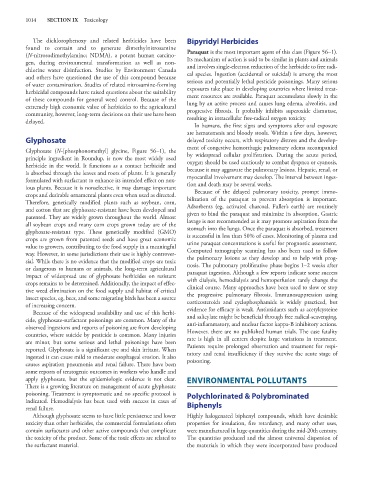Page 1028 - Basic _ Clinical Pharmacology ( PDFDrive )
P. 1028
1014 SECTION IX Toxicology
The dichlorophenoxy and related herbicides have been Bipyridyl Herbicides
found to contain and to generate dimethylnitrosamine
(N-nitrosodimethylamine; NDMA), a potent human carcino- Paraquat is the most important agent of this class (Figure 56–1).
gen, during environmental transformation as well as non- Its mechanism of action is said to be similar in plants and animals
chlorine water disinfection. Studies by Environment Canada and involves single-electron reduction of the herbicide to free radi-
and others have questioned the use of this compound because cal species. Ingestion (accidental or suicidal) is among the most
of water contamination. Studies of related nitrosamine-forming serious and potentially lethal pesticide poisonings. Many serious
herbicidal compounds have raised questions about the suitability exposures take place in developing countries where limited treat-
of these compounds for general weed control. Because of the ment resources are available. Paraquat accumulates slowly in the
extremely high economic value of herbicides to the agricultural lung by an active process and causes lung edema, alveolitis, and
community, however, long-term decisions on their use have been progressive fibrosis. It probably inhibits superoxide dismutase,
delayed. resulting in intracellular free-radical oxygen toxicity.
In humans, the first signs and symptoms after oral exposure
are hematemesis and bloody stools. Within a few days, however,
Glyphosate delayed toxicity occurs, with respiratory distress and the develop-
ment of congestive hemorrhagic pulmonary edema accompanied
Glyphosate (N-[phosphonomethyl] glycine, Figure 56–1), the
principle ingredient in Roundup, is now the most widely used by widespread cellular proliferation. During the acute period,
herbicide in the world. It functions as a contact herbicide and oxygen should be used cautiously to combat dyspnea or cyanosis,
is absorbed through the leaves and roots of plants. It is generally because it may aggravate the pulmonary lesions. Hepatic, renal, or
formulated with surfactant to enhance its intended effect on nox- myocardial involvement may develop. The interval between inges-
ious plants. Because it is nonselective, it may damage important tion and death may be several weeks.
crops and desirable ornamental plants even when used as directed. Because of the delayed pulmonary toxicity, prompt immo-
Therefore, genetically modified plants such as soybean, corn, bilization of the paraquat to prevent absorption is important.
and cotton that are glyphosate-resistant have been developed and Adsorbents (eg, activated charcoal, Fuller’s earth) are routinely
patented. They are widely grown throughout the world. Almost given to bind the paraquat and minimize its absorption. Gastric
all soybean crops and many corn crops grown today are of the lavage is not recommended as it may promote aspiration from the
glyphosate-resistant type. These genetically modified (GMO) stomach into the lungs. Once the paraquat is absorbed, treatment
crops are grown from patented seeds and have great economic is successful in less than 50% of cases. Monitoring of plasma and
value to growers, contributing to the food supply in a meaningful urine paraquat concentrations is useful for prognostic assessment.
way. However, in some jurisdictions their use is highly controver- Computed tomography scanning has also been used to follow
sial. While there is no evidence that the modified crops are toxic the pulmonary lesions as they develop and to help with prog-
or dangerous to humans or animals, the long-term agricultural nosis. The pulmonary proliferative phase begins 1–2 weeks after
impact of widespread use of glyphosate herbicides on resistant paraquat ingestion. Although a few reports indicate some success
crops remains to be determined. Additionally, the impact of effec- with dialysis, hemodialysis and hemoperfusion rarely change the
tive weed elimination on the food supply and habitat of critical clinical course. Many approaches have been used to slow or stop
insect species, eg, bees, and some migrating birds has been a source the progressive pulmonary fibrosis. Immunosuppression using
of increasing concern. corticosteroids and cyclophosphamide is widely practiced, but
Because of the widespread availability and use of this herbi- evidence for efficacy is weak. Antioxidants such as acetylcysteine
cide, glyphosate-surfactant poisonings are common. Many of the and salicylate might be beneficial through free radical-scavenging,
observed ingestions and reports of poisoning are from developing anti-inflammatory, and nuclear factor kappa-B inhibitory actions.
countries, where suicide by pesticide is common. Many injuries However, there are no published human trials. The case fatality
are minor, but some serious and lethal poisonings have been rate is high in all centers despite large variations in treatment.
reported. Glyphosate is a significant eye and skin irritant. When Patients require prolonged observation and treatment for respi-
ingested it can cause mild to moderate esophageal erosion. It also ratory and renal insufficiency if they survive the acute stage of
causes aspiration pneumonia and renal failure. There have been poisoning.
some reports of teratogenic outcomes in workers who handle and
apply glyphosate, but the epidemiologic evidence is not clear. ENVIRONMENTAL POLLUTANTS
There is a growing literature on management of acute glyphosate
poisoning. Treatment is symptomatic and no specific protocol is Polychlorinated & Polybrominated
indicated. Hemodialysis has been used with success in cases of Biphenyls
renal failure.
Although glyphosate seems to have little persistence and lower Highly halogenated biphenyl compounds, which have desirable
toxicity than other herbicides, the commercial formulations often properties for insulation, fire retardancy, and many other uses,
contain surfactants and other active compounds that complicate were manufactured in large quantities during the mid-20th century.
the toxicity of the product. Some of the toxic effects are related to The quantities produced and the almost universal dispersion of
the surfactant material. the materials in which they were incorporated have produced

